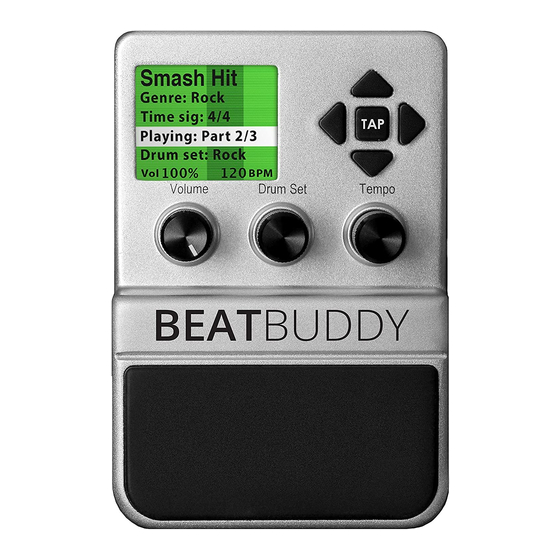
Singular Sound BeatBuddy Instruction Manual
Midi controls
Hide thumbs
Also See for BeatBuddy:
- Manual (56 pages) ,
- User manual (44 pages) ,
- Quick start manual (20 pages)
Advertisement
Quick Links
Advertisement

Summary of Contents for Singular Sound BeatBuddy
- Page 1 MIDI Controls...
- Page 2 Table Of Contents MIDI Commands Program Change (CC) summary MIDI Settings MIDI-IN Channel (1-16) Sync Start Stop Note On Note Off Tempo (MSB:106 LSB:107) Mix-Vol (CC-108) HP-Vol (CC-109) Accent-Hit (CC-110) Pause/Unpause (CC-111) Drum Fill (CC-112) Transition (CC-113) Outro (CC-115) Tap-Tempo (CC-117): MIDI-OUT Output Type: Channel (1-16)
- Page 3 BeatBuddy (BeatBuddy is called “ Slave” ) and for your BeatBuddy to control other devices (BeatBuddy is called “ Master” ) , making it a very powerful tool for live performance and recording.
- Page 4 1. Sync your looper to the BeatBuddy: MIDI Sync is a powerful tool to integrate the BeatBuddy with your other MIDI enabled devices, such as MIDI Sync enabled loopers and effects, to create a powerful performance or recording system. For example, when the BeatBuddy is synced with a MIDI Sync enabled...
- Page 5 The BeatBuddy has the capability to stream out the MIDI notes it is playing. You can connect the BeatBuddy to your computer to record the MIDI notes as the BeatBuddy is playing, so you can have the ease of playing the BeatBuddy to lay down the beat, but also keep the powerful capabilities of working with MIDI notes.
- Page 6 You can connect the MIDI OUT from the drum set to the MIDI IN on the BeatBuddy and when you play on the electronic drum set, it will play the BeatBuddy’s award winning super high quality sounds! This is also useful when you’re composing beats in your DAW...
- Page 7 ● All (Omni): This mode can be chosen if you want to receive MIDI messages on all the possible channels. Sync ● Enable: The BeatBuddy sets its own tempo based on the tempo (MIDI Clock) that it receives. ● Disable: BeatBuddy ignores any tempo sent to it.
- Page 8 Note On ● Enable : When the BeatBuddy receives MIDI notes, it will play the corresponding sounds on the BeatBuddy drum sets. This is very useful if you want to play an electronic drum set but hear the high quality BeatBuddy sounds.
- Page 9 Accent-Hit (CC-110) ● Enable : The Beatbuddy will play the current song part accent hit each time it receives the Accent-Hit MIDI message. You can control the volume of the accent hit by changing the value of the message ranging from 0 to 127.
- Page 11 ● Disable : The BeatBuddy ignores all Transition Fill message it receives. Outro (CC-115) ● Enable : The BeatBuddy will trigger the outro of the song when a Outro message is received. ● Disable : The BeatBuddy ignores all Outro message it receives.
- Page 12 ● MIDI-MERGE : BeatBuddy combines any MIDI commands it receives in the MIDI-IN port with its own generated commands and sends both commands to the MIDI-OUT port. ● MIDI-THRU : BeatBuddy only sends out MIDI commands that it has received through the MIDI-IN port. Channel (1-16) ●...
- Page 13 ● Pause and End : BeatBuddy sends out the MIDI Stop command when BeatBuddy has been paused and when the outro ends. ● End Only : BeatBuddy sends out the MIDI Stop command only when the outro ends.
- Page 14 ● Disable : BeatBuddy does not send out the CC102 command. Some devices (such as the Eventide Timeline) get confused when they receive this command and do not operate properly. Time Signature ● Enable : BeatBuddy sends out Time Signature information. This is...
- Page 15 Folder/Song Select You can select a BeatBuddy folder and song with the MIDI Bank Select and Program Change messages. The folder is selected with the Bank Select Message (Bank MSB and LSB) and the song is selected with the Program change. Each of the 128 values of Bank MSB value can have 128 folders as selected by the value of Bank LSB.
- Page 16 (Program Change). However, it’s a bit more complicated because unlike the Song Selection system where INC/DEC (see. h ttps://www.midi.org/specifications Here are the common steps to do to control the BeatBuddy’s tempo. It follows the Data INC/DEC specification of the MIDI protocol: Step to increment tempo Step...
- Page 17 Tempo MSB & Tempo LSB To directly set the tempo to a specific BPM, we need to use the Tempo MSB and Tempo LSB. The Beatbuddy will update its current tempo only when receiving the LSB message. So the order of the message should 1.
- Page 18 MIDI Commands Program Change (CC) summary Value Action Numbe CC-0 [0-12 Bank (Song folder) Select MSB CC-32 [0-12 Bank (Song folder) Select LSB CC-96 [1-127 Data increment (+1) – INC CC-97 [1-127 Data decrement (-1) – DEC CC-98 [0-12 NRPN_LSB...
- Page 19 CC-99 [0-12 NRPN_MSB CC-106 [0-12 Tempo MSB CC-107 [0-12 Tempo LSB CC-108 [0-10 Change the Mixer Volume (Main Volume knob) CC-109 [0-10 Change the Headphone Volume CC-110 [0-12 Triggers an accent hit with a volume from the value 0 (mute) to 100 (original recorded volume) to 127 (amplified more than the original recorded volume) CC-111...
- Page 20 It is possible to start a song with a transition. Quits the transition and go to specified part CC-114 >0 Starts the playback of the current song CC-115 [1-127 Triggers the outro of the song CC-116 [1-127 Selects a specific drumset CC-117 Enters Tap Tempo mode and generate Tap Event used...






Need help?
Do you have a question about the BeatBuddy and is the answer not in the manual?
Questions and answers